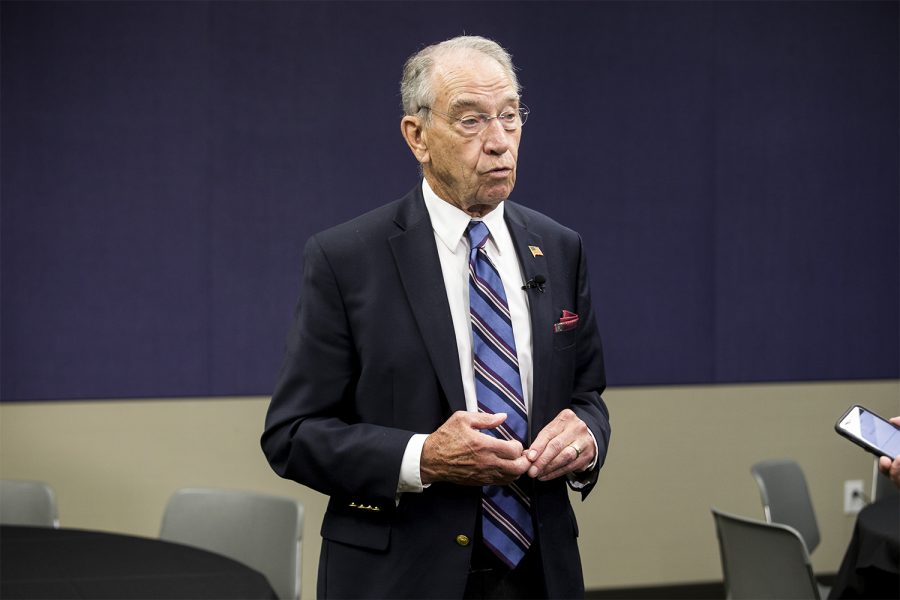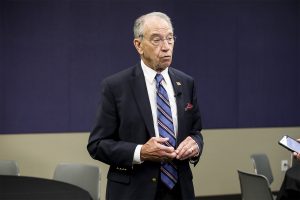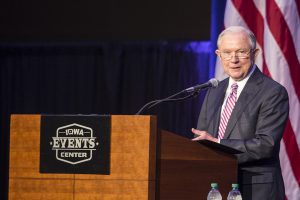Senators lose summer break, sort of
The U.S. Senate went back into session in August, but sessions have been as short as 22 seconds.
Then-Senate Judiciary Committee Chair Chuck Grassley, R-Iowa, talks to reporters at the Eight Circuit Judicial Conference in Des Moines on Friday, Aug. 17, 2018.
August 20, 2018
Parting from tradition, Iowa senators are back at work in Washington following the cancellation of the August recess.
Sen. Chuck Grassley, R-Iowa, said on Aug. 17 that the Senate is working to pass 12 appropriation bills instead of an omnibus appropriation bill, a single bill that includes a variety of subjects, which Congress has used in years past.
“If we can just accomplish that by working during August, we’ve accomplished something,” Grassley said on Aug. 17 at a judicial conference in Des Moines.
The first official recess occurred in 1971 as part of the Legislative Reorganization Act of 1970; it was designed to allow members of Congress to spend time with family and connect with constituents in an increasingly yearlong job.
The cancellation of the recess this year comes ahead of the midterm elections, where nearly a third of senators are campaigning for re-election. Grassley and Joni Ernst, R-Iowa, are not up for re-election this year.
According to the Pew Research Center, the last time Congress had a significant cut to its August recess during an election year was in 1994, when lawmakers focused on health care and crime legislation. The Senate delayed its recess until Aug. 25.
Ernst supports the cancellation, saying she believes Congress needs to stay in Washington to get work done.
“If that requires us to stay in session 24 hours a day, seven days a week, then that is what we should be doing,” she said in a June 5 statement.
However, many of the meetings of the Senate during the break/nonbreak have been brief pro forma sessions, as documented by the Congressional Record. The meetings allow the Senate to remain in session even if a majority of senators are not anywhere near Washington. The sessions this August have lasted an average of 22 seconds before adjournment.
During this additional convening of the Senate, lawmakers hoped to address legislative priorities including appropriations bills and judicial nominations from President Donald Trump.
The Senate confirmed two of Trump’s judicial nominees, Marvin Quattlebaum and Julius Richardson, to serve as U.S. judges for the 4th Circuit on Aug. 16 with a 62-28 vote and an 81-8 vote, respectively.
The Senate Judiciary Committee also has been reviewing the thousands of documents needed to begin Sept. 4 hearings for Trump’s U.S. Supreme Court pick, Judge Brett Kavanaugh, Grassley told reporters Aug. 17 in Des Moines.
The Senate has also worked on a spending bill for the Defense Department, H.R. 6157, which would set appropriations for the Pentagon for the fiscal year ending Sept. 30.
Senate Majority Leader Mitch McConnell, R-Ky., announced the August recess cancellation in June with a week break at the beginning of the month.
“Due to the historic obstruction by Senate Democrats of the president’s nominees, and the goal of passing appropriations bills prior to the end of the fiscal year, the August recess has been canceled,” McConnell said in a statement then.
With McConnell’s announcement, the Senate is on track to be in the chamber 385 days in a two-year session, according to a Pew research analysis. The number is higher than the average number of days the Senate has been in session, which is 317.





